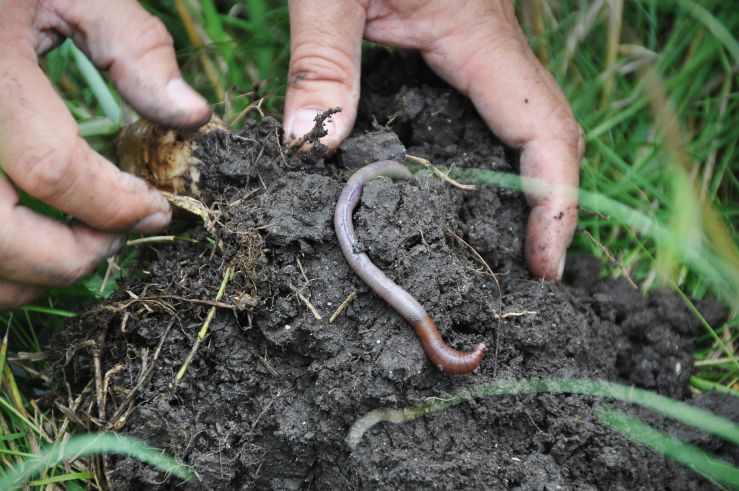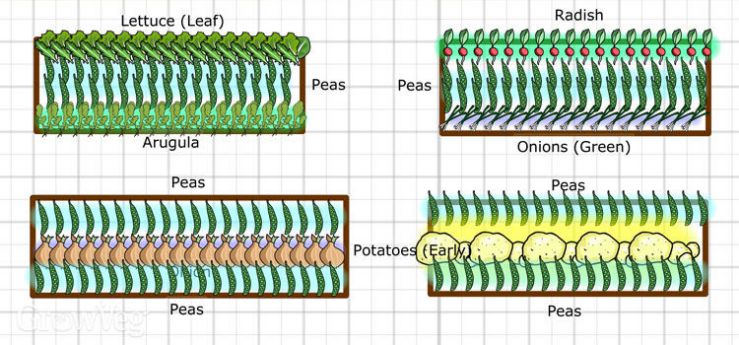Background:
Organic matter (OM) comprises a small percentage of most soils by volume, however, it plays a crucial role in soil health and ecosystem services because of its interaction with many other soil properties. Soil OM increases the soil’s water holding capacity, cation exchange capacity, fertility, microbial abundance and diversity, and soil structure. Soil OM provides essential nutrients and water for plants, sources of energy and nutrients for microbial communities essential in many ecosystem functions such as detoxifying pollutants, and reduces erosion and runoff by improving infiltration. Soil OM is the largest pool of terrestrial carbon, containing 77% more carbon than above-ground vegetation, playing a significant role in climate regulation.1
Most soils range in OM from 1 to 6% depending on chemical, biological, and physical properties of the soil, as well as anthropogenic activities that promote or impede OM accumulation.2 Soil OM accumulation depends on inputs and rates of decomposition of organic inputs, which are in turn a function of moisture, temperature, aeration, microbial community composition and abundance, physical disturbance, and mineralogy. High organic matter inputs help increase soil OM; this can be achieved in areas of high primary productivity, by returning crop residues or cover crops to the soil, or by adding compost and/or manure to the soil. Some soils are naturally low in OM, especially in water limited environments, where biological activity, including primary productivity and microbial activity, are low. In cold environments organic matter accumulation can be limited by temperature. Mineralogy of the soil is also important - minerals in the silt and clay fractions of the soil can bind organic compounds helping to stabilize the carbon and protect it against decomposition. Anthropogenic activities also affect the amount of organic matter in the soil. For example, tillage aerates the soil and increases the availability of stored carbon, increasing microbial activity and therefore rates of decomposition. Furthermore, land use changes, such as forest clearing for cropping or grazing can also significantly reduce carbon pools in the soil. Understanding the role and management of soil OM can greatly enhance plant productivity and yields.

Picture of organic matter aggregate and worm. https://www.flickr.com/photos/usdagov/24878004088
Diagnosing:
Dark-colored surface soils are a good visual indication of organic matter accumulation. In mineral soils, total carbon can be measured in soil laboratories and soil organic matter can be estimated by multiplying the total percent carbon by two.
Management:
Below is a short summary of various management practices. For a full list of additional resources click here.
Inputs for enhanced OM accumulation
Increasing soil OM can be achieved by increasing the amount of OM inputs, and limiting the removal of biomass after harvest. The following are strategies to increase OM inputs.
- Application of manure, compost, returning crop residues to the field (e.g., rather than burning), and cover cropping can increase OM in soils. Care should be taken to not add excess amounts of manure in one year to avoid the risk of nutrient loss and the accumulation of salts.
- Growing perennial crops with deep rooting systems can contribute carbon deeper in the soil profile where it is better protected against microbial decomposition and physical disturbance
- With all inputs to a system, the carbon to nitrogen ratio of the material should be taken into account so as not to make nitrogen limiting in the soil. Material can be tested for total carbon and nitrogen in a lab. A list of typical carbon to nitrogen ratios of common materials can be found here

Example of interplanting
https://res.cloudinary.com/growinginteractive/image/upload/q_80/v1445981402/growblog/pea-plan-2x.jpg
Retention and Recycling of OM and Minimizing Loss
The introduction of oxygen into the soil will accelerate the decomposition of OM due to increased microbial activity. Additionally, breaking apart aggregates, which are glued together by OM, will allow for the exposure of previously physically protected OM to be exposed and vulnerable to decomposition by microbes. Furthermore, the topsoil, where microbes are most active, is where most OM is found and thus, loss of topsoil should be mitigated. The following practices help reduce aeration of soil and minimize erosion.
- Reducing practices that aerate the soil, such as tillage. If tillage is being used for weed control, such as in organic systems, mulching can be used instead to reduce weed pressure. If resources are limiting, mulching a small area directly around the plant could help minimize weeds near the plant. However, for certain soils and economically viable crop yields, tillage is sometimes necessary. A farmer should assess if tillage is required. If yields can be maintained, conservation tillage can be implemented if there are no other barriers or negative consequences to implementation.
- Preventing erosion and increasing water infiltration and storage to mitigate topsoil loss for enhanced crop growth and carbon sequestration
- Mitigating the reduction of microbial biomass and diversity to increase organic matter accumulation. Implementing crop rotations, interplanting, and preventing non-native species encroachment and deforestation can help maintain a healthy microbial biomass.
- Avoid slash and burn agricultural practices and overgrazing. Implementing agroforestry practices, such as intercropping profitable tree crops to row crops can stabilize topsoil. Rotating livestock frequently can allow forage to regrow and be grazed again.
- Balanced fertilization to facilitate efficient nutrient use, maximal growth of vegetation, and large quantities of biomass that can be returned to the soil.
Nutrient Cycling in Soils.
Resources:
Inputs for enhanced OM accumulation
- Information from the USDA Natural Resource Conservation Service on the Carbon to Nitrogen ratio: https://www.nrcs.usda.gov/Internet/FSE_DOCUMENTS/nrcseprd331820.pdf
- How to compost by the USA Environmental Protection Agecy: https://www.epa.gov/recycle/composting-home
- Brief summary of OM dynamics and management from Cornell University Cooperative Extension: http://franklin.cce.cornell.edu/resources/soil-organic-matter-fact-sheet
- New South Wales, Australia Government website on building soil organic matter with varying agricultural management practices and inputs https://www.dpi.nsw.gov.au/agriculture/soils/structure/organic-matter
Retention and Recycling of OM and Minimizing Loss
- Summary of tillage practices by the Sustainable Agriculture Research and Education Organization: https://www.sare.org/Learning-Center/Books/Building-Soils-for-Better-Crops-3rd-Edition/Text-Version/Reducing-Tillage/Tillage-Systems
- University of California Division of Agriculture and Natural Resources document on types of tillage in irrigated row cropping systems: http://casi.ucanr.edu/files/43650.pdf
- UC ANR extension document on conservation tillage and weed control https://soilhealth.ucdavis.edu/download_file/view/221/234
- Iowa State University extension bulletin on the relationship between tillage and OM https://soilhealth.ucdavis.edu/download_file/view/222/234
- Brief brochure on agroforestry from CGIAR and ICRAF https://soilhealth.ucdavis.edu/download_file/view/219/234
- USDA informational website on agroforestry https://www.usda.gov/topics/forestry/agroforestry
- FAO website on agroforestry http://www.fao.org/forestry/agroforestry/en/
Additional Resources
- An overview of soil organic matter, its cycling, and why it is important from the Sustainable Agriculture Research and Education Organization: https://www.sare.org/Learning-Center/Books/Building-Soils-for-Better-Crops-3rd-Edition/Text-Version/Organic-Matter-What-It-Is-and-Why-It-s-So-Important/Why-Soil-Organic-Matter-Is-So-Important
- FAO document on organic matter dynamics, OM’s importance for soil health, and practices that effect OM in soil: http://www.fao.org/3/a-a0100e.pdf
- Summary of tillage practices by the Sustainable Agriculture Research and Education Organization: https://www.sare.org/Learning-Center/Books/Building-Soils-for-Better-Crops-3rd-Edition/Text-Version/Reducing-Tillage/Tillage-Systems
- University of California Division of Agriculture and Natural Resources document on types of tillage in irrigated row cropping systems: http://casi.ucanr.edu/files/43650.pdf
- UC ANR extension document on conservation tillage and weed control https://anrcatalog.ucanr.edu/pdf/8200.pdf
- Iowa State University extension bulletin on the relationship between tillage and OM https://soilhealth.ucdavis.edu/download_file/view/222/234
References:
- http://www.ipcc.ch/ipccreports/sres/land_use/index.php?idp=3
- https://www.sare.org/Learning-Center/Books/Building-Soils-for-Better-Crops-3rd-Edition/Text-Version/Organic-Matter-What-It-Is-and-Why-It-s-So-Important/Why-Soil-Organic-Matter-Is-So-Important
- Nelson, D.W. and L.E. Sommers, 1982. Total carbon, organic carbon and organic matter: In: A.L. Page, R.H. Miller and D.R. Keeney) Methods of soil analysis. Part 2 Chemical and Microbiological Properties, pp: 539-579.

